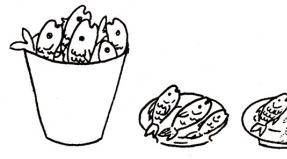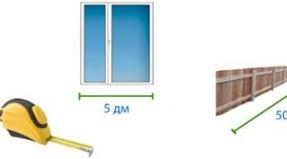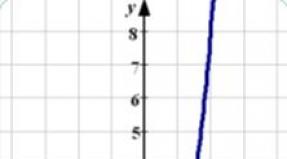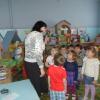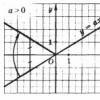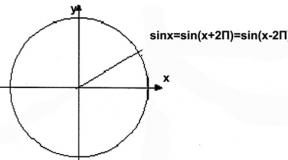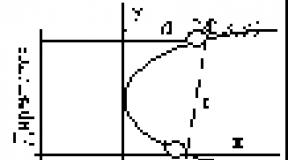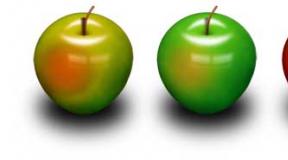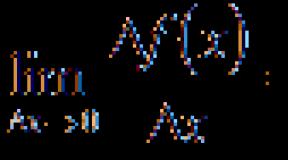Math games. Collection of math games (for preschoolers) Math games for preschoolers 3 5
Quantity and count
Game "Who will find a flower for a butterfly"
The teacher puts paper flowers around the room. Their number should correspond to the number of children playing. Then he gives out one butterfly to the children. Clarifies how many butterflies each child has. Children should find a flower nearby and plant their butterfly on it. The teacher checks whether the task was completed correctly. Clarifies what is more (less): flowers or moths
Game "Bear and Bees"
Children sit on chairs - bees sit in their hive houses. The teacher says: “Tanya is a bee, Ira is a bee, Valya is a bee, Sveta is a bee. How many bees do we have? " “There are many bees,” the children answer. "Seryozha will be a bear," says the teacher and asks: "How many bears?" - "One Bear". Bees fly around the meadow. As soon as the bear leaves its den, the bees scatter to their houses (sit on chairs). “Here the bees flew into the clearing: one bee, another bee, one more bee - many bees. There were many bees, a bear came - the bees got scared, scattered to their houses. In this house there is one bee, in this house there is one bee and in this house there is one bee. How many bees are there in each house? " - "One." - "The bear did not catch the bees and went to sleep." The game is repeated several times. The teacher fixes the attention of children on the concepts of "one", "many". For this game, you can make a hat for a bear and bees or use outline images. After the game, the attributes are removed, while paying attention to where there is one object, and where there are many: "Here is one hat, one more, one more, but together there are many"
Aircraft game
PURPOSE: consolidation of the concepts "one", "many".
Small planes of two or three colors stand on the chairs. Educator. You are all pilots. Lena is a pilot, Kolya is a pilot, Ira is a pilot. How many pilots do we have? Children. Many. Educator. This is an airfield. There are planes there. How many planes are there at the airport? Each of you will take a plane. How many planes did Zhenya take? How many planes did Ira take? Red planes flew. Now the yellow planes are flying. All planes flew. How many planes? Children. Many planes. Educator. Red planes are landing. (Children with red planes sit on chairs.) Then, at the signal of the teacher, the rest of the groups of planes land. During the game, the teacher constantly draws the attention of children to the number of planes: “How many planes are in the hands of Kolya, Ira, Zhenya? How many planes are there? How many have landed? How many took off? How much sits down?
»Game" Colorful lanterns "
The teacher gives each a multi-colored flashlight. At the same time, he asks the child how many flashlights he has in his hands, how many flashlights his neighbor has, what color the flashlights are. The lanterns went on and started dancing. "How many lanterns are dancing?" - "A lot." - "How many flashlights are in the hands of Katya, Nina, Vera?" - "One, one more." - "Morning came. The room became light. The blue lanterns went out (the children sat down), the yellow lanterns, red and green, went out. How many flashlights does Rita have? How many flashlights does Tanya have? " Children answer. The evening comes again, it gets dark, the lanterns are lit and they start dancing. The game repeats itself. After the game, the children put the flashlights into the box, naming how many flashlights Kolya, Sveta, Ira have in their hands, how many flashlights Tanya, Valya put, how many flashlights are in the box. Thus, the teacher teaches children to see not only the set as a whole, but also its component parts, each of which is distinguished by a certain color of objects. It is necessary to constantly change visual material: it can be flowers, dolls, lanterns, leaves, animal figurines, etc.
Game "Train"
PURPOSE: exercise in finding objects of the environment: one and many.
In different parts of the room, toys are placed according to the themes "Zoo", "House of dishes", "House of toys". Children, standing one after another, form a locomotive and carriages. The train is ready for departure. The teacher asks how many locomotives have turned out, how many cars. A signal sounds and the train starts moving. Having approached the zoo, he stops. The teacher asks: “What animals live in the zoo? How many are there? " Children call: "One bear, one lion, many monkeys." The train hits the road again. Next stop is near the House of Dishes. Children tell what kind of dishes are sold, for how many items of dishes: "Many plates, many cups, one saucepan, one ladle, one vase, one jug, many spoons, many forks." The third stop is near the Toy House. The game continues.
Game "Butterflies and Flowers"
PURPOSE: to establish equality between two groups of subjects
Flowers are lying on the floor at a short distance from each other, one row below the other. There are as many of them as there are children in the group. The teacher invites all children to imagine themselves as butterflies. Have a few children say they are butterflies. How many butterflies? Many. The butterflies flew. Children, waving their arms - "wings", "fly" around the room. At the signal: "Butterflies sit on flowers!" - each child should stand near a flower lying on the floor. The teacher clarifies: on this flower there is a butterfly, on this flower there is a butterfly, on this flower there is a butterfly. - Which is more and which is less: flowers or butterflies? - Equally, as many flowers, as many butterflies. Rested "butterflies" and flew again. The game is repeated 2-3 times. During the game, you need to put another 1-2 flowers so that it turns out not equally. And then ask the children what is more: flowers or butterflies.
The game "Sparrows and the car"
Children-"sparrows" sit in their "nests" - hoops, lying on the floor in 2 rows at a short distance from each other. In the opposite corner of the room with a steering wheel in his hands is a child - he is the driver of the car. Educator. You are sparrows. Each "sparrow" has its own nest. There are as many nests as there are sparrows. "Sparrows" flew out of their nests, flapping their wings, flying. Educator. A car drives out of the garage. "Sparrows" fly away to their nests. The car is returned to the garage. Educator. Did all the "sparrows" have enough nests? What is more? What is less? Maybe equally? Children answer questions and the game repeats
Fast train game
A train is being built from the chairs in a row. There can be as many players as there are carriage chairs, and more or less. Passengers walk along the platform, getting ready for departure. A beep sounds. Passengers take their seats. The teacher, together with the children, finds out whether there was enough space for everyone, compares what is more or less: cars or passengers. Having determined what is more, less, equally, the children hit the road. The train rushes to another station, stop - the passengers get off. The game starts again. The teacher can clean up, add the number of cars, so that each time a comparison is made, there is a new situation for the children. In such games, it is better if there are one more items than the playing ones. This will avoid conflict situations and will not upset children.
Game "Cat and Mice"
Exercises children in establishing equality-inequality between two groups of objects. For the game, minks for mice are prepared - chairs that stand in two rows, one row opposite the other. Mouse children are housed in burrows. The cat is sleeping. The mice came out of their holes and went for a walk. At the signal: "The cat is coming!" - all mice hide in burrows. The teacher asks: “How many mice? How many cats? Did all the mice find minks? What is more, less, equally, as much as? " (Children answer different questions.) The cat sleeps again, the mice go out for a walk again. (The teacher changes the number of minks, removes or adds one chair.) If the cat catches one mouse, compare how many minks and mice. The cat lets go of the mouse, it takes up its hole; now there are as many minks as mice, mice as many as minks.
Game "Fisherman and Fish"
Helps to consolidate the concepts of "one" and "many", contributes to the formation of skill in establishing equality-inequality between two groups of objects. The chairs are in a circle, there are as many of them as there are children. Chairs are pebbles at the bottom of the river, behind which fish will hide. One child is a fisherman. He sits on the shore with a fishing rod. The fish swim freely. At the signal: "There is a fisherman!" - fish swim away and hide behind pebbles. The teacher says: “A fish hid behind this pebble, and a fish hid behind this pebble. How many pebbles, so many fish. What is more, what is less: fish or pebbles? " After the children's answers, the game is repeated
Game "Birds"
Forms the ability to establish equality-inequality between two groups of objects. Each child-bird makes a house for himself, laying out the cord in the form of a circle. The nests are arranged in two rows at a short distance from one another. Birds fly, rejoice at the sun, sing their songs. Suddenly the wind blew, the weather turned bad, it was going to rain. The birds hid in the houses. Educator: "In this nest there is a bird, in this nest there is a bird." Children, looking at the opposite row, compare nests and birds, establish what is more, less, equally.
The games "Butterflies and Flowers", "Beetles and Dragonflies", "Horses" are also held.
Download:
Preview:
To use the preview, create yourself a Google account (account) and log into it:
Interesting math games are aimed at teaching your kid the basics of math. These games develop visual-figurative thinking in children, teach to compare, acquaint with the quantitative composition of numbers, the proposed games introduce children to numbers and their numerical designations, teach to solve the simplest mathematical problems.
"Who goes to visit in the morning"
The game of composing a set of two subsets, to consolidate the concept of "one", "many", "none"
Required inventory: plot toys, circles of two colors: red and yellow.
◈ How we play: "Who goes to visit in the morning, he acts wisely, taram-param, taram-param, that's what morning is." Play with toys, tell us that guests have come to us in the morning and you need to treat them with apples (circles). There are apples on the plate: how many are there? (Many.) And the guests? (Few.) First hand out the yellow apples and ask, "How many more apples are left?" (Many.) "Which ones?" (Red.) Give them too. "How many apples are on a plate?" (Not a single one left.) “How many apples were given to each guest? (One at a time.) "How many yellow, red apples?" (Many). "How many apples are there in total?" (There are many apples, some of them are red and yellow.)
◈ To fix it: if you wash apples in the kitchen, offer to arrange them in plates according to color. Note that there are many apples, but there are many among them, for example, green and yellow apples (many apples are composed of a subset of yellow and green).
◈ When putting toys in the box, ask the same questions.
➣ Attention: What is little, how to define it? Laugh with your child: if the candies are tasty, we say that there are few of them. It turns out that "little" is a relative concept.
◈ Play the game "One - Many". "What items are there in the kitchen?" (Plates, spoons.) "And one object?" (Vase, painting, etc.) In the bathroom: one mirror, bathtub, rug, many shampoo tubes, towels, etc. Outside: many houses, leaves, etc.
Button buyer
The game teaches to use the mediated set; develops visual-figurative thinking.
Required inventory: coat with buttonholes, buttons, circles or tokens.
◈ How we play: how to buy the required number of buttons if the child cannot count? Very simple! Play around this situation: have the kid put the chips on the eyelets of his coat, then collect them and ask the "salesman" in the store (an adult): "Give me the same number of buttons as I have chips." The “seller” puts each token on the button and counts how many buttons to sell. And the "buyer" of the house must check whether the buttons were enough for him, was he not mistaken? Swap roles.
◈ To fix: on a piece of paper, glue or draw two groups of geometric shapes - one below the other. Note which is more, less, or equal. Imagine with your child, come up with what the figures can be, compare butterflies and flowers, caterpillars and leaves, etc.
◈ To complicate things: from each top figure, draw a path to the bottom figure - this is an equal sign (the sign itself can be omitted).
Buttons
The game reinforces the urge to compare two groups of objects
Required inventory: buttons of different colors, sizes and shapes.
◈ How we play: everyone has buttons at home. With their help, you can come up with a variety of games. Put, for example, round buttons up (they can be of different colors and sizes), and down under them - square ones. Shall there be more or less of them? Or put red round buttons up and blue square buttons down.
"Where did the sparrow eat?"
The game helps the child to understand that Quantity is a relative concept.
Necessary inventory: cut out of any books, magazines elephant, wolf, bear, hare, hedgehog, in scale they must be proportional to their real size, five squares - "cages" for animals of the corresponding different sizes.
◈ How we play: show the child pictures of a bear, a wolf and a hare, find out which of the animals is the largest, which is the smallest, which is the smallest, etc. They need to be placed in cages of the appropriate size.
◈ An elephant was brought to the zoo. He needs to take the largest cage. Note that the bear was the largest, and now the elephant is. Then the smallest animal, a hedgehog, was brought to the zoo. Pay attention to how the ratio has changed: the smallest was the hare, now the hedgehog. Compare again who is the biggest, who is the smallest, etc.
◈ Fastening: Compare shoes by size: mom's, dad's, baby's and doll's. Switch roles: the child asks, and you show. Compare anything: clothes, furniture. Don't forget the utensils in the kitchen. And if you compare a watermelon and a radish? And who is bigger: the giant or Uncle Styopa? And who is smaller: Thumbelina or gnomes, or maybe Boy-s-finger? On the street, compare the height of houses, trees, etc. This develops an eye.
First steps in mathematics
The game teaches you how to compare two groups of objects
Required inventory: dolls or other toys, cups.
◈ How we play: plant five toys and place four cups in front of them. “Now we will treat them to tea. Why did one toy cry? How can I help her? "
◈ Fix: in the future, you can bring the number of toys to 10.
◈ To complicate things: you can compare the number of objects by eye - real objects in the room, for example, glasses and cups, etc. What is more, less? If the child finds it difficult, stretch the strings or put sticks from one object to another (this is an equal sign).
Toddler pencils
The game introduces the child to the quantitative composition of a number of units
Required inventory: colored pencils of different colors.
◈ How we play: put the pencil on the table, notice that there is only one - red. To the right of it, put another one, but of a different color. Now there are two of them: one is red, the other is green. Hence, the number two consists of two ones. Put another pencil, for example, yellow. Say that the number three is made up of three ones. Bring the score to 5-10 in the same way. Remember the tale about the Kid, who could count to 10. How he saved the animals. Emphasize: "How good to be able to count!" What does your child think? And if everyone who was saved by the Kid is depicted in the form of circles? Stick them on and count, it turns out that your child is saving the heroes of the fairy tale. Praise him.
◈ To fix: play the game "Guess". How many units does the number 3, 4 consist of? Show numbers if the child knows them. Take different toys next time: a car, a hedgehog, a dog, a hare, etc. The number four consists of four units (one hedgehog, one car, one dog, one hare). Count from left to right and vice versa, stress that this will not change the amount. And if you put the toys in a circle, how can you remember which one you started to count from?
◈ Swap roles. Encourage your child constantly.
Bang Bang
The game introduces children to numbers
Required inventory: two hares, two carrots, numbers 1 and 2.
◈ How we play: take two bunnies or other toys from the toy box and tell a story about their friendship. About how one day they received parcels. One box contained one carrot and the other two. Why aren't they equally divided? Find out that one box has the number “1”, so there is one carrot in the box, the other has the number “2”, so there are two carrots in it. Introduce these numbers to the children. Do not forget to equalize gifts for bunnies so as not to offend them.
◈ Fix: this is how you can introduce other numbers (up to 10).
◈ Write these numbers in a notebook. You can also sculpt them out of plasticine.
School of the Wise Owl
The game teaches you to correlate the number of objects with their digital designation
Required inventory: cards with numbers, object pictures or toys, Wise Owl (toy or drawn).
◈ How we play: tell your child that the Wise Owl will come to visit you. Today she brought pictures and cards with numbers from 1 to 5 to them. Show the picture on which, for example, four cars are drawn. Have the child find the card with the number "4". Play the rest of the pictures in the same way. Will the child cope on his own, without the help of the Owl? Praise him for his diligence.
◈ Reinforce: we play the other way around - you show a card with the number "3", and the child must submit a picture on which three apples are drawn, etc. Change roles: the child shows cards with numbers, and you are looking for the desired picture. Or maybe the Wise Owl will help him?
◈ We play the game "Tasty Numbers" in the kitchen. We take three tangerines and find a card with the number "3", etc. Do not forget to invite the Wise Owl - let him eat.
◈ And if you attach the number "1" to the refrigerator, and the number "2" to the curtains? And the rest? Think about it. Let your child do it. If he has an interest in numbers, he will be happy to stick them on everything he finds, and you?
Counting counters
The game introduces the ordinal count. Required inventory: toys.
◈ How we play: put toys in a row on the table. Say that the Wise Owl has come to visit you again. She will play a game with you. You need to correctly answer who is in the first (second, etc.) place. We count from left to right. "Who stands between the hare and the bear?" “There's a squirrel here. She is the second ”, etc. Note that if the toys are counted from right to left, then those toys that were first will become the last.
◈ We fix: toys can be put one after another - with a train. Are you all at home? Play the little train. Who will be first: mom, dad? It's up to the child to decide. Be sure to pay attention to where the account is from.
◈ Find out who is in second place - mom or grandmother, and who is in third? What if the last carriage becomes a steam locomotive? Will the ordinal account change?
◈ Are you busy in the kitchen? Play this game in a new way: put different dishes on the table - a plate, a Cup, a spoon, etc. Ask what is in the first, second, third place. Swap dishes. Now they are different.
➣ Attention: quantitative composition is a composition of units, it does not change. And the ordinal composition can change if you count in a different direction. Don't mix it up!
Locomotive from Romashkovo
The game introduces the ordinal count
Required inventory: chairs.
◈ How we play: put the chairs one behind the other - this is a train from Romashkov. Invite children or adults to play with you. You can sing the Little Engine song from this animated film:
My cheerful steam locomotive passed the bridge;
He'll slow down now
He will invite you to land.
“Hey friends, come here soon!
Don't push at the door
Don't meow, don't bark,
Take your place quickly. "
◈ Where are we going? And at least where: to the zoo, to the dacha, etc. But be sure to beat.
◈ We fix: toys can also go, the driver is a child.
Clever girl
The game teaches you to solve the simplest problems
Required Inventory: Fruit Bowl.
◈ How we play: tell the child: “We have two apples in our vase, one I’ll give you. How many apples are left? Why will there be less of them? " Be sure to show everything with a visual example. "How can we make them more numerous?" - The child must put one apple in a vase. Come up with similar problems for everything that you have at hand. Use any situation to do this: have you bought your child new shorts, the third in a row? Ask, for example: "How many shorts do you have now?" Note that if we subtract, we say "left"; if we add, we say "became."
◈ We fix: on the street you saw children sitting, one left. Offer to come up with a problem about them and solve it. If the child knows the numbers, then you can write it down.
◈ Complicating: the child must come up with an oral problem, and you will solve it and will certainly make a mistake. Give your child the pleasure of correcting you.
Tasks of the Wise Owl
The game teaches you to solve the simplest problems of addition, subtraction: add, subtract 2; forms visual - figurative thinking
Required inventory: notebook, pencil, small items.
◈ How we play: today the Wise Owl will teach you how to solve problems. Place two red circles and two blue circles on the left in front of the child, and two blue circles on the right. Tell them they are enchanted forest dwellers. Offer to come up with a problem about them. Let the child fantasize: red circles can be squirrels and leaves. If the child does not cope, then the Wise Owl will come to the rescue. Tell her a poem:
Owl-owl, big head,
I sat on a bitch, turned my head ...
◈ Fix: we play in reverse. The child lays out circles, squares, and you solve problems. And if you have been waiting for a train for a long time and you have chalk? Or do you wash in the bathroom and the child helps wash the toys? Together with your child, come up with a problem about them. This will prepare your mathematician for school.
Fabulous mathematics
Required inventory: books of fairy tales with pictures.
◈ How we play: remember the fairy tales "Teremok", "Kolobok", "Turnip". Offer to count how many heroes of the fairy tale pulled a turnip, met Kolobok, lived in a house. And if the characters of "Teremka" are compared in height, in size? Who is the biggest, smallest? Who is smaller than a bear, but bigger than a bunny? And so on. And if they are "turned" into circles, pasted into a notebook and signed numbers under them? For example: a mouse is a gray circle, a frog is green, a bunny is white, and a top is a large gray circle.
◈ We fix: remember the tales of V. Suteev "Different Wheels" and "Under the Mushroom". How could animals hide under a mushroom, what happened to it? Why did not the cart roll in the fairy tale "Different Wheels"? (The wheels were of different sizes.) And if all the fairy tales were to be sketched? The whole Country of fabulous mathematics will turn out.
Useful verses
Seryozha fell into the snow,
And behind him is Alyoshka,
And behind him is Irinka,
And behind her is Marinka.
And then Ignat fell.
How many guys are there in the snow?
The hostess once came from the bazaar.
The hostess brought home from the market:
Potatoes, cabbage, carrots,
Peas, parsley and beets - oh! **
(How many vegetables did the hostess bring?)
Lady checked in luggage
Sofa, suitcase, bag,
Picture, basket, cardboard
And a little dog *
(How many items did the lady check in luggage?)
In the morning at Aibolit,
Until lunchtime,
Teeth are treated:
Zebras, bison,
Tigers, otters and beavers.
(How many different animals did Aibolit cure?)
Download:
Preview:
MATH GAMES FOR CHILDREN 3, 4 YEARS OLD
Interesting math games are aimed at teaching your kid the basics of math. These games develop visual-figurative thinking in children, teach to compare, acquaint with the quantitative composition of numbers, the proposed games introduce children to numbers and their numerical designations, teach to solve the simplest mathematical problems.
"Who goes to visit in the morning"
The game of composing a set of two subsets, to consolidate the concept of "one", "many", "none"
Required inventory: plot toys, circles of two colors: red and yellow.
◈ How we play: "Who goes to visit in the morning, he acts wisely, taram-param, taram-param, that's what morning is." Play with toys, tell us that guests have come to us in the morning and you need to treat them with apples (circles). There are apples on the plate: how many are there? (Many.) And the guests? (Few.) First hand out the yellow apples and ask, "How many more apples are left?" (Many.) "Which ones?" (Red.) Give them too. "How many apples are on a plate?" (Not a single one left.) “How many apples were given to each guest? (One at a time.) "How many yellow, red apples?" (Many). "How many apples are there in total?" (There are many apples, some of them are red and yellow.)
◈ To fix it: if you wash apples in the kitchen, offer to arrange them in plates according to color. Note that there are many apples, but there are many among them, for example, green and yellow apples (many apples are composed of a subset of yellow and green).
◈ When putting toys in the box, ask the same questions.
➣ Attention: What is little, how to define it? Laugh with your child: if the candies are tasty, we say that there are few of them. It turns out that "little" is a relative concept.
◈ Play the game "One - Many". "What items are there in the kitchen?" (Plates, spoons.) "And one object?" (Vase, painting, etc.) In the bathroom: one mirror, bathtub, rug, many shampoo tubes, towels, etc. Outside: many houses, leaves, etc.
Button buyer
The game teaches to use the mediated set; develops visual-figurative thinking.
Required inventory: coat with buttonholes, buttons, circles or tokens.
◈ How we play: how to buy the required number of buttons if the child cannot count? Very simple! Play around this situation: have the kid put the chips on the eyelets of his coat, then collect them and ask the "salesman" in the store (an adult): "Give me the same number of buttons as I have chips." The “seller” puts each token on the button and counts how many buttons to sell. And the "buyer" of the house must check whether the buttons were enough for him, was he not mistaken? Swap roles.
◈ To fix: on a piece of paper, glue or draw two groups of geometric shapes - one below the other. Note which is more, less, or equal. Imagine with your child, come up with what the figures can be, compare butterflies and flowers, caterpillars and leaves, etc.
◈ To complicate things: from each upper figure, draw a path to the lower figure - this is an equal sign (the sign itself can be omitted).
Buttons
The game reinforces the urge to compare two groups of objects
Required inventory: buttons of different colors, sizes and shapes.
◈ How we play: everyone has buttons at home. With their help, you can come up with a variety of games. Put, for example, round buttons up (they can be of different colors and sizes), and down under them - square ones. Shall they be equal, which are more or less? Or put red round buttons up and blue square buttons down.
"Where did the sparrow eat?"
The game helps the child to understand that Quantity is a relative concept.
Necessary inventory: cut out of any books, magazines elephant, wolf, bear, hare, hedgehog, in scale they must be proportional to their real size, five squares - "cages" for animals of the corresponding different sizes.
◈ How we play: show the child pictures of a bear, a wolf and a hare, find out which of the animals is the largest, which is the smallest, which is the smallest, etc. They need to be placed in cages of the appropriate size.
◈ An elephant was brought to the zoo. He needs to take the largest cage. Note that the bear was the largest, and now the elephant is. Then the smallest animal, a hedgehog, was brought to the zoo. Pay attention to how the ratio has changed: the smallest was the hare, now the hedgehog. Compare again who is the biggest, who is the smallest, etc.
◈ Fastening: Compare shoes by size: mom's, dad's, baby's and doll's. Swap roles: the child asks, and you show. Compare anything: clothes, furniture. Don't forget the utensils in the kitchen. And if you compare a watermelon and a radish? And who is bigger: the giant or Uncle Styopa? And who is smaller: Thumbelina or gnomes, or maybe Boy-s-finger? On the street, compare the height of houses, trees, etc. This develops an eye.
First steps in mathematics
The game teaches you how to compare two groups of objects
Required inventory: dolls or other toys, cups.
◈ How we play: plant five toys and place four cups in front of them. “Now we will treat them to tea. Why did one toy cry? How can I help her? "
◈ Fix: in the future, you can bring the number of toys to 10.
◈ To complicate things: you can compare the number of objects by eye - real objects in the room, for example, glasses and cups, etc. What is more, less? If the child finds it difficult, stretch the strings or put sticks from one object to another (this is an equal sign).
Toddler pencils
The game introduces the child to the quantitative composition of a number of units
Required inventory: colored pencils of different colors.
◈ How we play: put the pencil on the table, notice that there is only one - red. To the right of it, put another one, but of a different color. Now there are two of them: one is red, the other is green. Hence, the number two consists of two ones. Put another pencil, for example, yellow. Say that the number three is made up of three ones. Bring the score to 5-10 in the same way. Remember the tale about the Kid, who could count to 10. How he saved the animals. Emphasize: "How good to be able to count!" What does your child think? And if everyone who was saved by the Kid is depicted in the form of circles? Stick them on and count, it turns out that your child is saving the heroes of the fairy tale. Praise him.
◈ To fix: play the game "Guess". How many units does the number 3, 4 consist of? Show numbers if the child knows them. Take different toys next time: a typewriter, a hedgehog, a dog, a hare, etc. The number four consists of four units (one hedgehog, one typewriter, one dog, one hare). Count from left to right and vice versa, stress that this will not change the amount. And if you put the toys in a circle, how can you remember which one you started to count from?
◈ Swap roles. Encourage your child constantly.
Bang Bang
The game introduces children to numbers
Required inventory: two hares, two carrots, numbers 1 and 2.
◈ How we play: take two bunnies or other toys from the toy box and tell a story about their friendship. About how one day they received parcels. One box contained one carrot, and the other contained two. Why aren't they equally divided? Find out that one box has the number "1", so there is one carrot in the box, the other has the number "2", so there are two carrots in it. Introduce these numbers to the children. Do not forget to equalize gifts for bunnies so as not to offend them.
◈ Fix: this is how you can introduce other numbers (up to 10).
◈ Write these numbers in a notebook. You can also sculpt them out of plasticine.
School of the Wise Owl
The game teaches you to correlate the number of objects with their digital designation
Required inventory: cards with numbers, object pictures or toys, Wise Owl (toy or drawn).
◈ How we play: tell your child that the Wise Owl will come to visit you. Today she brought pictures and cards with numbers from 1 to 5 to them. Show the picture on which, for example, four cars are drawn. Have the child find the card with the number “4”. Play the rest of the pictures in the same way. Will the child cope by himself, without the help of the Owl? Praise him for his diligence.
◈ Reinforce: we play the other way around - you show a card with the number "3", and the child must submit a picture on which three apples are drawn, etc. Change roles: the child shows cards with numbers, and you are looking for the desired picture. Or maybe the Wise Owl will help him?
◈ We play the game "Tasty Numbers" in the kitchen. We take three tangerines and find a card with the number "3", etc. Do not forget to invite the Wise Owl - let him eat.
◈ And if you attach the number "1" to the refrigerator, and the number "2" to the curtains? And the rest? Think about it. Let your child do it. If he has an interest in numbers, he will be happy to stick them on everything he finds, and you?
Counting counters
The game introduces the ordinal count. Required inventory: toys.
◈ How we play: put toys in a row on the table. Say that the Wise Owl has come to visit you again. She will play a game with you. You need to correctly answer who is in the first (second, etc.) place. We count from left to right. "Who stands between the hare and the bear?" “There's a squirrel here. She is the second ”, etc. Note that if the toys are counted from right to left, then those toys that were first will become the last.
◈ We fix: toys can be put one after another - with a train. Are you all at home? Play the little train. Who will be first: mom, dad? It's up to the child to decide. Be sure to pay attention to where the account is from.
◈ Find out who is in second place - mom or grandmother, and who is in third? What if the last carriage becomes a steam locomotive? Will the ordinal account change?
◈ Are you busy in the kitchen? Play this game in a new way: put different dishes on the table - a plate, a Cup, a spoon, etc. Ask what is in the first, second, third place. Swap dishes. Now they are different.
➣ Attention: quantitative composition is a composition of units, it does not change. And the ordinal composition can change if you count in a different direction. Don't mix it up!
Locomotive from Romashkovo
The game introduces the ordinal count
Required inventory: chairs.
◈ How we play: put the chairs one behind the other - this is a train from Romashkov. Invite children or adults to play with you. You can sing the Little Engine song from this animated film:
My cheerful steam locomotive passed the bridge;
He'll slow down now
He will invite you to land.
“Hey friends, come here soon!
Don't push at the door
Don't meow, don't bark,
Take your place quickly. "
◈ Where are we going? And at least where: to the zoo, to the dacha, etc. But be sure to beat.
◈ We fix: toys can also go, the driver is a child.
Clever girl
The game teaches you to solve the simplest problems
Required Inventory: Fruit Bowl.
◈ How we play: tell the child: “We have two apples in our vase, one I’ll give you. How many apples are left? Why will there be less of them? " Be sure to show everything with a visual example. "How can we make them more numerous?" - The child must put one apple in a vase. Come up with similar problems for everything that you have at hand. Use any situation to do this: have you bought your child new shorts, the third in a row? Ask, for example: "How many shorts do you have now?" Note that if we subtract, we say "left"; if we add, we say "became."
◈ We fix: on the street you saw children sitting, one left. Offer to come up with a problem about them and solve it. If the child knows the numbers, then you can write it down.
◈ Complicating: the child must come up with an oral problem, and you will solve it and will certainly make a mistake. Give your child the pleasure of correcting you.
Tasks of the Wise Owl
The game teaches you to solve the simplest problems of addition, subtraction: add, subtract 2; forms visual - figurative thinking
Required inventory: notebook, pencil, small items.
◈ How we play: today the Wise Owl will teach you how to solve problems. Place two red circles and two blue circles on the left in front of the child, and two blue circles on the right. Tell them they are enchanted forest dwellers. Offer to come up with a problem about them. Let the child fantasize: red circles can be squirrels and leaves. If the child does not cope, then the Wise Owl will come to the rescue. Tell her a poem:
Owl-owl, big head,
She sat on a bitch, turned her head ...
◈ Fix: we play in reverse. The child lays out circles, squares, and you solve problems. But what if you have been waiting for a train for a long time and have chalk? Or do you wash in the bathroom and the child helps wash the toys? Together with your child, come up with a problem about them. This will prepare your mathematician for school.
Fabulous mathematics
Required inventory: books of fairy tales with pictures.
◈ How we play: remember the fairy tales "Teremok", "Kolobok", "Turnip". Offer to count how many heroes of the fairy tale pulled a turnip, met Kolobok, lived in a house. And if the characters of "Teremka" are compared in height, in size? Who is the biggest, smallest? Who is smaller than a bear, but bigger than a bunny? And so on. And if they "turn" into circles, stick them in a notebook and sign numbers under them? For example: a mouse is a gray circle, a frog is green, a bunny is white, and a top is a large gray circle.
Peas, parsley and beets - oh! **
(How many vegetables did the hostess bring?)
* * *
Lady checked in luggage
Sofa, suitcase, bag,
Picture, basket, cardboard
And a little dog *
(How many items did the lady check in luggage?)
* * *
In the morning at Aibolit,
Until lunchtime,
Teeth are treated:
Zebras, bison,
Tigers, otters and beavers.
(How many different animals did Aibolit cure?)
The main character of all games is Lutonyushka.
The fairytale hero Lutonyushka will be a ringleader, teacher, mentor here. He will teach young children everything that he himself knows how and what he owns.
Three times three
"Ku-ku-ku!" - the cuckoo shouts,
One, two, three - we count.
We know: how many dried pieces have been eaten,
How many cheesecakes were baked
How many rattles in the house,
How many meters of fringe.
It is very difficult to live without an account.
It is impossible to live without an account.
Each of Lutonyushka's students had their own favorite lesson. Crow Karkul was very fond of memorizing new words and tongue twisters. Pig Markush willingly listened to rhymes. The foal Galopik was fidgety, he loved to frolic and move. He was looking forward to a physical workout. Little Cat liked to write. Sheep Curly did not like to study, she dreamed of grazing in the meadow, pinching the grass, breathing air. Worst of all, and studied. And the counting lessons called "Three times three" were generally difficult for her. But the dog, Lyushka, was very fond of counting. I thought quickly, I always gave the correct answers: it would bark once, then two, then three, then six, then five, or even all ten times, but always as many times as it was necessary! And she counted the pieces of meat and bread that Lutonyushka gave her. Sometimes she even took offense, because she wanted five, but gave four. Animals mastered counting, and you can do it!
Fishermen
We give the concept of the number and the words "one", "two", "three", "many", "less", "more", "nothing", "the same";
Introducing the numbers 1, 2, 3;
Material for the game
Buckets and fish - toy or in the picture, pencils, this text.
Game progress
Chicken Dandelion for a long time persuaded daddy-cockerel Kukarekalik to go to the river and fish. Dad didn't really want to, because chickens mainly hunt worms, and they are not important fishermen. But nevertheless, he yielded to the persuasions of his beloved son. In the world you need to be able to do everything! And anything in the world happens. Maybe his son Dandelion, when he grows up, will not look for worms, but fish in a pond, or at least in Lutonyushka's aquarium!
Now listen to what Dandelion chicken said about his fishing:
We went fishing.
Dad and I were fishing.
And I want to boast:
I got a lot of fish,
And my daddy - a little bit
Or rather, only ONE.
And out of anger, poor dad
He threw the fish into the river.
Who needs help with bringing a bucket of fish?
1. Color the picture.
2. In which bucket of fish is it small? How many?
3. Circle the bucket with a lot of fish in it.
4. Draw another pencil around the bucket where there are no fish.
The chicken put the fish in the bowl for Kroshka. Help Dandelion chicken feed Igrunchik's kitten with fish. Take from the bucket and put the remaining fish in the bowl for the kitten that eats less than the cat (paint over).
.jpg)
5. Where there are more fish than less?
Name the first group of river dwellers in one word. Name the second group in one word.
.jpg)
Name their habitat.
Count how many fish, how many frogs. Who is more, who is less?
Someone is superfluous here. Leave only those who live in the water - circle with a pencil. Show who is crawling.
.jpg)
Game "Numbers and Clock"
Introducing numbers, practicing memorizing numbers, teaching counting
Material for the game
The dial is a picture or a real clock, cards and pictures.
Game progress
.jpg)
The clock counts the time
The numbers mean time.
To know these numbers,
You have to repeat a lot.
1. Run your finger on the dial, memorize the numbers and repeat:
One two three four five!
I will repeat twenty-five times -
I will know these numbers.
One two three four five!
I lived in the world for 5 years.
My cat is also 5.
My mom is twenty-five (25).
Pope Rome is thirty-five (35).
And Babula is forty-five (45).
.jpg)
Find the numbers marked on the flags on the dial, show them.
2. Look at the teapots. Count the teapots, show the number on the dial.
.jpg)
Find the differences between teapots. Count: how many roses? How many cones? Count the roses and cones together. Name the number, show it on the dial.
3. How many butterflies are on each flower? Enter the numbers you want.
.jpg)
4. Color the carrots. Count how many there are.
.jpg)
Find the number 4 on the dial.
5. Count how many peas are on the wings of ladybugs. Show the numbers on the dial.
.jpg)
6. Count how many legs the crow Karkuli has, the cockerel Kukarelik, the chicken Kokonyushka. How many eyes do they have?
.jpg)
7. Tell me how many legs the Sloppy pig has. Mumushka's cow? The horse Allyurka? Sheep Curly?
.jpg)
8. Count the animals! Show the number 3 on the clock face.
.jpg)
➢ Answer yes do it.
Choose an answer.
Birds have legs: three; five; two.
Animal legs: one; two; five; four.
Cross out the extra drawing. Explain why you chose him? How many birds are in the picture?
.jpg)
Game "One, two, three ... - Weeks days"
Introduce the concepts of "time", "week", with the days of the week; fix the account, develop memory
Material for the game
Calendar, clock.
Game progress
Winter countdown from Lutoni:
Winter is coming in the yard.
Tomorrow will be New Year.
The house has a pine scent.
I'll hang up a new calendar.
We live day and night -
We tear the sheet away in the morning.
Day after day, weeks, month,
Two and three, four, five ...
Twelve months have passed -
New Year has come again.
The spruce spirit is in the house again,
Let's start a new account!
The adult acts as the Week. Week appoints "artists" who will represent the Days of the week - her children. Week is asking a riddle:
Hanging on the wall, walking.
If they get up, they will lie. (Clock)
The clock is hanging on the wall
Time is measured.
The arrows go around in a circle -
Repeat time.
Weekly asks the question: "What is time?" and then gives an explanation.
Time is what lasts
That the invisible flees.
Of minutes, hours and days
Our time consists.
Day and night flashed by
We say: "Day away!"
The day is stacked a week
And weeks into months.
Time is barely weaving
And then it jumps, rages.
Week shows the calendar and asks from guessing one more riddle:
Hanging on the wall
He tells us about time.
It says January,
You will also find February in it ...
Its name is ... (calendar).
Time is our life's scheme
Time - days, minutes change.
There is a temporary inventory:
Clock and calendar,
Their people were invented in the old days.
To measure time
You need to know the days of the week.
The week calls all the guys into a circle, and then represents the first day of the week.
I went to bed late on Sunday
I woke up on Monday!
Monday come out
Lead our round dance!
A child assigned to the role of Monday comes to the center. Nedelka comments:
Monday everyone knows:
He starts the week.
A round dance goes around Monday and sings:
Monday is not fun
Monday is a hard day.
We rested, took a walk,
On Monday morning we got up:
You need to get used to business,
Worker rhythm to begin.
We start the second day,
We forget the day off.
Come out quickly to the courtyard,
Day of the second week - Tuesday!
Monday goes to the side. Tuesday comes out. Children walk around him and sing:
The king and the janitor will agree:
A wonderful day - Tuesday!
A lot of strength and desire
For any start!
Tuesday gets up next to Monday. The week names the third day of the week.
A series of days rushes:
After Tuesday - Wednesday.
Wednesday goes to the center of the round dance, the children sing:
We will remember this forever:
After Tuesday comes Wednesday.
Tuesday puts their hands on Monday's waist and Wednesday on Tuesday's waist, they form a chain that goes inside the circle and then leaves the circle. Children stop on the sidelines and say the words:
We always go one after another
We never change places:
Monday, Tuesday and Wednesday!
Everyone repeats:
Monday, Tuesday and Wednesday
They only walk like this
And in a different way NEVER!
Week continues to get acquainted with their children.
The day is gone, Wednesday is gone
Thursday's time has come.
He comes for Wednesday,
The fourth son, my own.
Thursday comes out in a circle with the words:
Wednesday day has passed, faded,
And I came, Thursday.
The round dance chants:
We see off Wednesday
We meet the fourth day!
Comes with a long-stemmed umbrella
It's a rainy Thursday on the track.
Thursday joins its sibling days and gets up for Wednesday. Comes out to the center Friday with the words:
The rain is over, Thursday is over
The fifth day the fourth overthrew.
For the fourth I am,
Even though I'm tired - I smile.
After all, Friday is Saturday.
Taking a break from work.
The round dance recites:
Smile all around
Friday came to our house!
Tomorrow we will all rest
From toil and vanity.
Friday, you are the best!
Friday gets up after Thursday. Saturday appears inside the round dance.
Maybe someone with Friday
Reluctance to part.
But must appear
I followed her, Saturday!
All past days of the week
Younger sister.
Unnoticed by the dark night
I'll fly like a bird
Because following me
Brother Sunday is racing.
A round dance meets her with the words:
We all like Saturday afternoon
Day of the sixth week,
The penultimate stage.
Wait saturday wait
Walk with a round dance!
Saturday goes around with a round dance, and then gets up for Friday. Sunday appears. The week announces:
Sunday, my best son!
He comes for Saturday, -
An island of happiness, the sun.
Sunday introduces itself:
I appear over Saturday
And I follow her like a shadow.
I am called Sunday.
Sunday is the best day!
I close the week
Monday I meet.
A round dance goes around Sunday and chants:
Sunday, Sunday -
The best day in the world!
Sunday rises after Saturday. "Days of the week" form a chain, the round dance closes around them. "Days" in a chain join hands and recite:
We walk side by side, but not together.
We know the strict order.
We are one another place
We concede without scandals!
The round dance chants:
Monday, Tuesday and Wednesday
Wednesday walking Thursday,
Friday Saturday Sunday -
You are a strict example,
Time of the current division.
"Days of the week" proclaim:
We live on sheets of a calendar
To help everyone
It's not in vain to live your day.
➢ Answer yes do
Remember the days of the week, list them and say: how many are there?
Like a carousel place
Every day of one week.
Monday is an elephant
Tuesday is a high-spirited conic.
And Wednesday is a whirligig, a spinning top,
And Thursday is a lame bull.
Friday is a monkey
And Saturday is a mouse.
Sunday is a motley cow.
Monday...
Remember again!
Look at the calendar leaflet and draw your own: come up with a design and write the number for your birthday.
Circle the clock and numbers by dots. How many digits are on the dial? How many arrows?
.jpg)
Learn the rhyme:
A maned horse gallops in the field,
The hungry dog \u200b\u200bin the booth is crying
A cannon is shooting on the mountain
The cuckoo clock strikes in the house.
Who does not count the blows
Leaves us now!
Draw a picture yourself using the text of the rhyme.
Above, below - very simple!
We give an idea of \u200b\u200bthe concepts "higher - lower", "high", "low","Low - high"; we form an idea of \u200b\u200bordinal numbers
Material for the game
This text.
Game progress
Lutonyushka came to class, greeted, went to the window and began to tell:
The garden is beautiful behind the glass
And our house is in the garden.
House with a beautiful red roof.
Nearby, the poplar roof is ABOVE.
If the poplar of the roof is higher
Does this mean our house is BELOW? -
he asked and called:
Come gentlemen
Look over there!
The animals huddled at the window, and the teacher asked them to look out the window and select a tree or shrub and compare it from above.
- See see! - shouted horse Allurka. - Poplar of all trees is higher! Apricot, plum, cherry ...
- Here are two apple trees growing: old and young. And no need to guess here - below the young! - the cow Mumushka has authoritatively declared.
- The apricot of raspberries is higher, our house is lower than the apple tree, - compared the foal Galopik.
- And the gooseberries are below the plum! - noticed the goat Bekalka.
Our pear at the porch
I found a warm place.
Covers the roof
And it grows higher and higher!
Pears often at night
They knock on the roof as they fall.
Rolling on the roof
Below, below, below ...
Rolled - rolled,
Clap on the ground - and crashed! -
the foal Galopik burst out with a poetic story.
- And the flowers are lower than the trees, and the grass-ant is lower than all the flowers, spreads along the ground, as if covering the ground with a carpet of curly hair, - said Curly the sheep.
- Everything you have is curly! - the goat Bekalka forged the lamb.
- And here I am above you! He boasted.
- Just think, giant! Just a little bit higher, ”Curl was offended.
- And I'm taller than you, goat! - said the foal.
- And who is our lowest? - asked the kitten Igrunchik.
- You, of course! - said the goat Mekalka.
- Not true! - the cat was offended.
- Let's not argue, - asked Lutonya. - Now we will do what: we will line up according to the ranking!
“I don’t understand,” Markusha's pig worried. - I don't know such a word: rank.
- We do not know such a word! Cried all the animals.
- By rank means by height. First the tallest will rise, and then lower it, even lower, lower, lower ...
- I'm the tallest! - the horse Allurka boasted and stood up first. Next to her stood the cow Mumushka, next to the cow - the foal Halopik, next to the foal - the Horny goat, next to the bull - the goat Bekalka, next to the goat - the goat Mekalka, next to the goat - the sheep Curly, next to Curly - the pig Markush , next to the pig is the piglet Neryashka, next to Neryashka is the cat Kroshka, next to the cat Kroshka is the cat Igrunchik, next to the cat is the mouse Shurshishka.
Our squad has lined up
We didn't all get up
And by height:
ABOVE, BELOW, below ...
- Very simple! - commented the pig Neryashka. - The LOWEST of us is the mouse Shurshishka. The HIGHEST is a horse.
The horse is higher
The mouse is below.
The roof is higher
The windows are below.
The sky is higher
The ground is low.
Above is a bush
Than a radish. -
Lutonyushka gave the command:
- Calculate! - And everyone began to call themselves:
- I am a horse, my number one!
I always stand in front of everyone!
- And I am a cow, number two,
Grass helped me to become tall!
- I'm colt number three,
Who's the fourth? Speak!
- I am a bull, and my number is four,
I am the most formidable in this world!
- And I'm a goat, my number five,
It's good for me to stand fifth!
- I'm a goat, my number six.
I have two horns and an udder!
- I am a sheep, my number seven,
Only the stump does not see my beauty!
- I'm a pig, number eight is mine.
I dream of not being the first
But at least the second.
“I'm piglet number nine.
Ninth me, what can I do!
- I am a cat Little, number ten.
I get fat every month from Whiskas.
- And I did not even enter the top ten.
But I am growing and recovering well, -
Said Igrunchik, a nice cat,
Meowed and closed his mouth.
- I will never be higher than anyone, -
The mouse said barely audibly.
➢ Answer yes do
Answer the question.
A rank is:
1) fish oil;
2) orange color;
3) a spender;
4) construction by height and size.
Look at the numbers on the plate below and find the number that represents your age.
Name someone below the mouse.
Read and memorize.
Below the mouse are cockroaches
Spiders, bugs and midges.
Vases are taller than glasses.
Above the slippers - sandals.
After the animals had settled and introduced themselves to each other, Lutonya commanded:
- Right!
Everyone turned to the right and found themselves one after the other.
- Forward! - gave one more command to Lutonyushka.
The animals walked forward to the door. The Horned Bull, a courtyard poet, started a marching song of his own composition.
Sparrows, small sparrows, Black raven flies high. In the flower garden, in the flower garden, scarlet roses,
Below is a yellow buttercup looking.
One - looks,
Two - looks,
Three - looks!
He never goes to heaven
Will not take off!
Don't look, don't look, don't look!
Sit on the ground, on a flower bed!
The detachment marched across the room and went out into the street. And so the animals walked one after another, a ladder and with a daring song. So we entered the courtyard. We stopped without breaking the formation. There Kukarekulik rooster, Kokonyushka hen and chickens joined them.
I'm a motley cock,
My number is thirteen
In the morning "Ku-ka-re-ku!"
I scream twenty times! -
the cockerel reported.
And I'm a simple chicken.
Che-tyr-over-tsa-taya!
I don't fly, but I fly
I am from the perch to the ground.
I hang high at night
In the morning I walk on the ground! -
the chicken Kokonyushka presented itself as a riddle.
Everyone started off and continued to sing their drill song.
High, high, sun,
The birds sing songs with joy.
Thunder will strike, thunder will strike - lightning,
The clouds will fall to the ground!
A drop of one, a drop of two -
Rain started.
Jets in puddles
Dance to rock and roll!
Enough, thunder, enough, thunder, rumble!
We can't reach the sky from earth!
➢ Answer yes do
Count how many short chickens (chickens) and how many tall. How many chickens are there?
.jpg)
Listen to the poem, look at the drawing (a turret of cells) and paint the houses of the giant and the cockroach in different colors.
Cockroach and giant
A cockroach was crawling on the floor.
A giant walked across the field.
The cockroach crawled onto the field
I was glad to the sun, I was glad to the will
The giant did not meet him:
He did not notice the barbel.
A cockroach for a giant
What is a speck of dust for a dune:
Although he did not hide evil,
I crushed the cockroach.
Don't go cockroaches
Where the giants walk!
The giant is tall
He does not see the land.
You will fall under his feet -
Wouldn't hurt you for anything.
.jpg)
Name and count: how many are in the picture of those who fly. How many are there who live on earth?
Give one word to everyone in the picture.
.jpg)
Guess the riddles about the insects drawn above.
I'm not an animal, not a bird,
My nose is like a knitting needle. (Mosquito)
I fly and buzz
I walk on plants. (Bug)
I have eyes like headlights
I'm dancing to the fanfare
I am light, slender, carefree,
I will have fun forever
Fly from flower to flower
Summer is hot to dance. (Dragonfly)
I'm jumping among the greenery
I jump and chirp.
My wings are legs
There are horns on the top of the head. (Grasshopper)
I fly from flower to flower
I know that she is very beautiful.
I am a wonderful living flower,
Everyone admires me. (Butterfly)
Figures know the count too
We give the concept of a triangular figure; we fix the concepts "circle", "oval", "rectangle"; learning to count, learning to find something like that
Material for the game
Triangular objects, the given text.
Game progress
Lutonyushka gave an assignment to the goat Bekalka: to bring an object similar to a triangle to the lesson. The goat brought flags of different colors and read a poem, which he himself composed about him.
I'm going home happy.
Fresh breeze, free
Flutters my triangular flag.
In the lesson, the animals counted the flags, played with them, and Lutonya explained that the flag looks like a triangle and showed how to draw. "
Draw a triangle - circle the points.
.jpg)
1. Count how many vertices the triangle has. Show number 3 on the dial.
2. Count how many sides a triangle has, how many angles. Show the number on the dial.
Draw a circle, oval, square, rectangle.
.jpg)
Trace the dots around the star. Count how many triangle rays the star has. How many corners? Show the numbers on the dial.
.jpg)
Count triangles, circles, ovals.
.jpg)
Look at the numbers and draw the same number of ovals, circles and cherries.
.jpg)
How many parts are the figures made of?
.jpg)
Cells - squares
Material for the game
Blank notebook, pencils, cubes.
Game progress
For the lessons in the Preparatory Class, books and notebooks were needed. Lutonyushka bought the books in the store himself, and Allurka asked the horse to go to the stationery store and bring the notebooks from there in a ruler and a box. It is impossible without notebooks! They write and draw in them. Letters are written in rulers, and numbers are written in cells, and you can draw by cells. You just need to learn how to count cells.
Take a clean notebook. It is drawn into cells or, in another way, into squares, only into small ones. Lutonya, when showing the notebook, explained:
At the children's notebook:
Small cells.
And then he turned to his students with a request:
Only there are a lot of cells. And I would be very happy. If you could remember: This cell is a square.
Find the squares in the scarf pattern.
.jpg)
1. Count the black squares on the scarf.
2. Paint over the blank squares on the scarf.
Show (circle) a square in objects.
.jpg)
Open the notebook.
1. Circle one cell with a pencil. Circle the other next. Color in both squares with a colored pencil.
2. Draw a pencil around one cell and the other below. Paint both cells green.
3. Circle 2 cells. Leave the cell under the first (it is below) empty. Count 2 more cells from it along the line and circle them. Paint all the cells red. Look at the figure that turned out!
4. Count and circle 3 cells. Paint over the cage in the middle with a yellow pencil and blue around the edges. Circle the square above the yellow cell (which is above) and paint also in blue. Now circle and paint over the square below the yellow square. Admire: it turned out to be a flower!
5. Count three cells. Circle. Paint over with blue pencil. Find the second square, which is in the middle, and circle the square above it (above it).
Game "A square climbed into a triangle"
Reinforcing the concept of "triangle" and "square" shapes
Material for the game
Squared notebook, pencils, this text.
Game progress
Lutonyushka finished explaining what a square is, how triangles can be made from a square, how to draw in a notebook different figures in cells, which are also squares. And then he decided to check how the pupils - pets understood his explanation. He gave them independent work, and he walked around the classroom, approached the animals, looked into their notebooks and watched who and how of his charges worked, what he did in the notebook.
The foal took the notebook.
I drew in it in order:
Cell, cell - two squares.
Down squares, up squares
Four cells - a figure.
Five squares - a flower.
Well done, sheared!
A cockerel was sitting next to him, coloring the cells and saying:
Cell - one! The second is down!
Two rushed forward.
And connect the ends.
We receive the flag.
This is a triangular flag:
The triangle is a red banner.
.jpg)
Connect the dots and get triangles.
.jpg)
Draw a triangular shape according to the pattern - Paint over the triangle.
1. Circle the square in your notebook. Join the top corner of the square with the bottom corner obliquely: you get two triangles. Color the triangles in different colors.
2. Circle the cage. Connect the upper corner of the square with the lower one obliquely, only now in a different direction: you get two triangles. Color both with different pencils.
3. Circle the cage. Connect the lower corners to the upper corners obliquely in one direction and the other. How many triangles did you get? Color all four triangles with different colors.
The game "The boat swam through the cells"
We draw by labels; we consolidate the concept of "square" and "triangle" figures
Material for the game
Squared notebook, pencils, this book with assignments.
Game progress
The pigs - Markush's mother and her son, the piglet Neryashka - did not part in the classroom. They sat at the same table and drew a boat.
Markush's mother taught her son: “Count three cells. Paint over the second cell. At the first and third cells, paint over the upper corners (divide the square into two triangles). From the second cell up, count two cells and also paint over the corner. "
Do as Markush teaches. Not understood? Then listen to the piggy Nerdyashka.
Piglet Neryashka was a diligent and obedient student in Lutonyushka's class. Everything worked out for him. He sat, drew and muttered to himself:
One, two, three - we count the cells.
Our color will be blue.
Triangle on the first.
And a square for the second.
It turned out, I'm looking!
Time, time, time -
Paint over this corner!
Oink oink! One, two!
Count the cells up.
Oink oink oink...
We know the triangle.
Need a red pencil ...
Let's paint over the triangle -
And our boat sailed!
Math games are very clear. At the same time, the child naturally forms abstract thinking of numbers 1 2 3 4 5 6 7 8 9. Familiar characters, colorful design and clear examples from life teach the child the basics of analysis, juxtaposition and comparison of objects in mathematics. And the words count, addition, subtraction and multiplication will never scare your child again.
Much knowledge in preschool age is not easy for a child. But, perhaps, it is especially difficult to teach a kid to math games. Since this happens for a child with certain difficulties, it is important not to scare him away from mathematics at all. This means that acquaintance with the queen of sciences “mathematics” should take place in an exciting format.
Psychologists know: you can interest and captivate everyone, even the most restless child. For example, special developing mathematical games for preschoolers 1-2-3-4-5-6-7-8 years old will help create a positive atmosphere of such an acquaintance. Spending time with them, the child will, without noticing it, get acquainted with numbers, simple techniques of operating with numbers, will begin to clearly navigate in the concept of "more or less".
When solving arithmetic problems, the kid is motivated by the fact that he wants to find the right answer. Every right decision is a small victory, so it is a reward in itself. For him, this is a habitual play activity, during which new knowledge is unconsciously deposited. Information is received latently, in an entertaining format. This means that the child does not need to be forced to learn new material. And this applies not only specifically to mathematical knowledge. A young explorer is born in whom natural curiosity will not be stifled.
The free section "Math Games" is perfect for your child if you want to improve his knowledge of mathematics. These games are aimed at knowing numbers. This educational section in the form of educational games will definitely please your child.
In the section "Math games online" the child will be able to learn how to count to 10, correctly name the numbers, and will also be able to solve some math examples: addition, subtraction, or even multiplication and division. In the examples, several answer options will be given, from which he will have to choose the correct one.
The games in this section are aimed primarily at teaching the child. You won't find entertaining games here. We advise you to combine educational games with entertainment. After each material covered, include something for him to relax, so he will not get bored and will be much harder to work with educational games. Teaching numbers is not an easy process, so your little one may need help or guidance at a certain level of difficulty. Do not be lazy and sit with your child solving these math problems. This will greatly help your child to master the numbers much faster. Also, do not allow the child to sit at the computer for too long, this also applies to the learning process, with the help of special games. The child should take a break of ten minutes after every 40 minutes of class.
